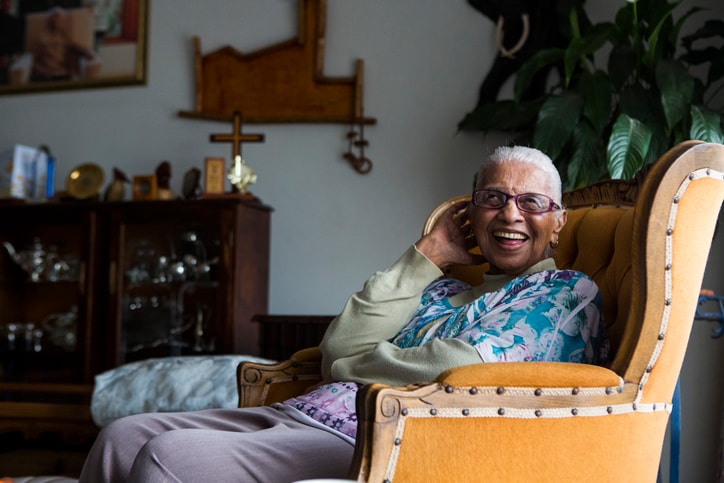Whether you’re preparing to sell a house, move yourself or an aging parent into a retirement community, travel the world or just want to minimize clutter, paring down your own or a senior loved one’s possessions can have a lot of benefits. But there’s also an emotional side to letting go of cherished possessions — and it can be a lot of hard work.
When going through the process of downsizing, it’s important for older adults and family caregivers to be gentle with one another, says Bonnie Scott, a therapist and the founder of Mindful Kindness Counseling. “Life transitions are always hard in some way, and there will be a lot of difficult conversations.”
Here is what Scott and other experts have to say about how to make this big job go more smoothly, including helpful downsizing tips for seniors, as well as advice on how to work through the complex emotions that come with this major life change.
Why is downsizing important for seniors?
There are a number of reasons why seniors might consider downsizing, including alleviating financial strain, considering future health and mobility needs and having greater freedom to enjoy their retirement years.
“Transitioning into senior life is a good time for downsizing because life is changing,” Scott says. “Making conscious choices about what spaces we live in and what items we bring to those spaces is part of the transition. Downsizing space and belongings can be a way to simplify the move into senior adulthood.”
Most often, she adds, downsizing happens in preparation for one or more of the following changes:
- Selling a home that is too large to maintain.
- Making room for home health care needs.
- Creating space for visiting family and grandchildren.
- Moving into assisted living, a retirement community or other senior living space.
- Managing long term illness or disability.
- Preparing for travel.
- Moving to a space with a lower cost of living.
Additionally, says Kris Hargrove, a professional organizer and the founder of Organized By Kris, aging causes many people to think about their futures and what they will eventually leave behind for their loved ones.
“Over the years, we accumulate a lot of stuff if we don’t declutter regularly,” she explains. “That ‘stuff’ is what our loved ones have to deal with when we move to long term care or pass away. This creates both physical and emotional stress for them.”
In this way, downsizing can be seen as an act of love and care, as well as a practice that brings families closer together.
“Transitioning into senior life is a good time for downsizing because life is changing. Making conscious choices about what spaces we live in and what items we bring to those spaces is part of the transition. Downsizing space and belongings can be a way to simplify the move into senior adulthood.”
— Bonnie Scott, a therapist and the founder of Mindful Kindness Counseling
Downsizing help for seniors: What to do before you get started
Downsizing is a long process, and the more prepared you are, the easier it will be. Before you start digging through boxes in the attic or bubble-wrapping knick knacks for storage, here’s what our experts recommend doing to set yourself up for success.
Communicate about priorities
“Preparing for downsizing begins with realistic communication,” Hargrove says. Together with family, friends or anyone else who plans to help with downsizing, discuss the following:
- Why does downsizing need to happen?
- Which items or spaces are the highest priority?
- What are essential items to keep?
- Which items will be claimed by relatives or loved ones?
- Is there a place to store anything long term?
- What is a realistic amount of space for items that will be kept?
- What does the final outcome need to look like?
Set a reasonable timeline
Decide when downsizing sessions will take place and when the project needs to be completed, Hargrove suggests. “Without a deadline, the process can drag on for months or even years as family members find time to help.”
Also, don’t forget to set a date for when family-claimed items will be picked up, she cautions. “If a family member is accepting items being passed down, establish a firm deadline,” she says. “Otherwise, communicate that the item will be given to someone else or sold.”
Make a plan for items that won’t be kept
Research and decide what to do with the items the senior isn’t keeping, Hargrove says. Consider these possible solutions:
- Have an estate sale.
- Organize a yard sale.
- Consult an antiques dealer to sell valuables.
- Take items to a consignment shop.
- Donate items to local charity, shelter or veteran’s organization.
6 expert downsizing tips for seniors
Once you’ve made a plan for downsizing, here are the next steps experts recommend.
1. Start with the easy stuff
You can downsize in any order that works for you, but Scott suggests starting with spaces that are less emotionally taxing. “It’s easier to start with areas that have less sentimental items and move to the more sentimental spaces,” she offers. “[For example], it’s probably emotionally safer to start in a garage or backyard shed than it is to start in a bedroom closet.”
2. Go room-by-room and item-by-item
If you try to do too many things at once, you’re likely to get distracted or overwhelmed. “Start by sorting and categorizing items in each room to identify what stays and what goes,” Hargrove says. “Go through everything in each room. If something is leaving the house, decide whether it’s being gifted, sold, donated or thrown away.”
3. Stay as organized as possible
Hargove suggests using a Sharpie and a few different colors of painter’s tape to quickly label each item in a room as something to keep, donate, sell, giveaway (label with the person’s name!) or toss in the trash.
Next, Scott recommends sorting items into boxes labeled donations, storage, etc. You can even create a container for items you still need to think about, she adds.
Most importantly, Hargrove emphasizes, clean and get rid of trash as you go so unwanted items don’t get in the way as you move through your living space.
4. Don’t move too fast
Downsizing can be incredibly taxing — both physically and emotionally — so it’s better to take it slow, Scott says. “It’s not realistic to think a lifetime accumulation of belongings will be managed in a few days,” she adds. “If it’s possible in the situation, plan to take some time (weeks or even months), and be thoughtful about it.”
5. Be open to letting go
Sometimes family members and loved ones don’t want to take possession of treasured belongings or family heirlooms. This is a common source of conflict during downsizing, Hargrove says.
“Try not to take it personally,” she advises seniors facing this situation. “Allow them to keep what feels important to them — something they will cherish as a memory of you and the time you spent together. It could be as simple as letters you wrote to each other or a piece of jewelry. You want your loved ones to accept what will bring them joy, not feel guilt because they were pressured to take something.”
6. Hire a professional
Both Scott and Hargrove recommend hiring a professional home organizer if the option is available. “It’s helpful to people to have guidance and accountability, plus a professional brings a fresh eye to a space,” Scott explains.
Some of the biggest perks of hiring a professional organizer include:
- Keeping the project on track.
- Reducing stress between family members.
- Having help with removing donations.
- Learning the best places to sell things.
- Having help setting up estate or yard sales.
Professional help is also a must for seniors who live solo. “If the senior’s family members don’t live nearby or don’t have time to assist, getting professional help is the fastest and easiest way to downsize effectively,” Hargrove says.
Hire a home organizer.
“Talk about your feelings with loved ones and be supportive of one another. Take the chance to share and listen to family stories that are tied to belongings and spaces.”
— Bonnie Scott
Processing the emotions that come with downsizing
For many older adults and their families, downsizing is a deeply emotional process. Our belongings are frequently tied to our identities, relationships and communities, and parting with them involves a complex process of grieving, accepting change and perhaps even coping with some fear about the future.
You’ll likely experience a range of emotions, Scott says, including sentimentality, sadness and nostalgia. You might even experience some more difficult feelings, like regret, anger or resistance to the process.
“Talk about your feelings with loved ones and be supportive of one another,” Scott advises. “Take the chance to share and listen to family stories that are tied to belongings and spaces.”
If you’re letting go of items you don’t have room for or that family members don’t want, find ways to honor those items and the memories that go along with them.
“One way to think about family heirlooms differently is to consider that when they’re donated, sold to an antique store or given to another family, you’re allowing the new owners to begin their own history and legacy,” Hargrove says. “Writing a note that shares the story of how the heirloom was passed down through your family can help your traditions continue with the next person or family.”
The bottom line on downsizing for seniors
Downsizing can be a long, complicated and often emotional process, but it becomes necessary for almost everyone as they age. Rather than thinking of it as a chore, consider it an opportunity to pay tribute to a lifetime of meaningful items and to get clear about your priorities as you enter the next stage of life.
Taking the process step-by-step, staying organized and asking for support when you need it can help downsizing go more smoothly. During this process, you can also take the opportunity to reminisce and reaffirm your bonds with those closest to you.
“It can be a connecting project for families to work on together,” Scott offers. “And that mindset will help families manage any of the tough stuff that might come up along the way.”





